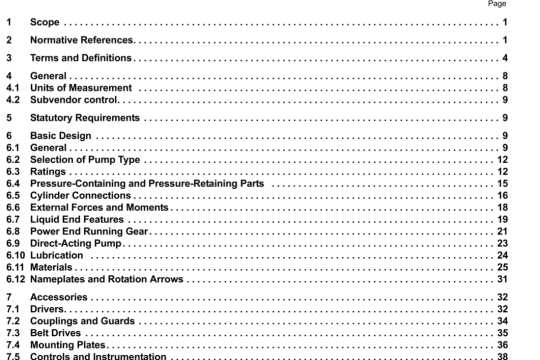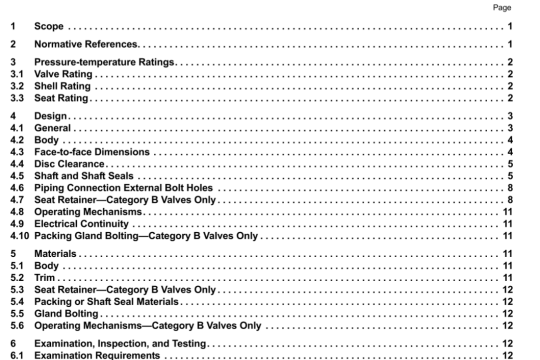API MPMS 5.1:2005(2011) pdf download
API MPMS 5.1:2005(2011) pdf download.Manual of Petroleum Measurement Standards Chapter 5—Metering Section 1—General Considerations for Measurement by Meters.
5.1.7.1.5 A back-pressure valve may be required to maintam the pressure on the meter and the prover above the fluid vapor pressure. In general. displacement meters do not aced- crate fluid velocity and are not nomially subject to the resulting pressure reduction that can cause vapon/ation (cavitation) in other types ol meters.
5.1.7.2 PIPING INSTALLATION
5.1 .7.2.1 Meters are normally installed in a hori,ontal position. The manufacturer shall be consulted if space limitations dictate a different position. For example. Coriolis meters are sometimes installed vertically.
5.1.7.2.2 Where the flow range is too great for any one meter. where shutting down the metering system is impractical, or where frequent service is needed, a bank of meters may be installed in parallel. Each meter in (he bank shall be operated within its minimum and maximum flow rates. A means shall be provided to balance flow through each meter.
5.1.7.2.3 Meters should be installed and operated to have a maximum, dependable service life. This may require that protective devices be installed to remove from the liquid abrasives or other entrained substances which could stop the metering mechanism or cause premature wear. Strainers, filters, sediment traps, settling tanks, water separators, a combination of these items, or any other suitable devices, can be used. ‘they should be properly sued and installed to not adversely affect the operation of the meter or the overall system. Protective devices may be installed singly or in an interchangeable battery, depending on the importance of continuous service. Monitoring devices should be installed to determine when the protective device needs to be cleaned.
5.1.7.2.4 Meters shall be installed and operated to perform satisfactorily within the viscosity, pressure, temperature, and flow ranges that will be encountered.
5.1.7.2.5 Meters shall be adequately protected from pressure pulsations, from excessive flow surges and from excessive pressure caused by then’nal expansion of the liquid. This kind of protection may require the installation of surge tanks. expansion chambers, pressure-limiting valves, relief valves, or other protective devices. When pressure relief valves are located between the meter and the prover, a means of detecting leakage from the valves shall be provided.
5.1.7.26 Any condition that contributes to the release of vapor from the liquid stream shall be avoided through suitable system design and through operation of the meter and prover within the how range specified by the manuficturer.
This section covers recommended operating practices for meter installations. All operating data that pertain to measureinent, including the meter factor control charts, should he accessible to interested parties.
5.1.9.1 CONDITIONS THAT AFFECT OPERATIONS
5.1.9.1.1 The overall accuracy of measurement depends on the condition of the meter and its accessories, the temperature and pressure corrections, the proving system, the frequency of proving, and the variations, if any. between operating and proving conditions. A meter factor obtained for one set of conditions will it necessarily apply to a changed set of conditions.
5.1.9.1.2 Meters should be operated with the manufacturer’s recommended accessory equipment and within the range of flow rates specified by the manufacturer. Meters should be operated only with liquids whose properties are consistent with the design of the installation.
5.1.9.1 .3 If a meter is to be used for bidirectional flow, meter factors shall be obtained For flow in each direction.
5.1 .9.1 .4 Iailure to remove foreign matter upstream of a meter run may result in mismeasurement and’or meter damage. Strainers, filters, or other protective devices should be placed upstream of the meter run.
5.1.9.2 PRECAUTIONS FOR OPERATING NEWLY INSTALLED METERS
When a new meter installation is placed in service. patlicularly on newly installed lines, foreign matter can be earned to the metering mechanism during the initial passage of liquid. Protection should he provided from malfunction or damage by kreign matter. such as air or vapor, slag, debris, welding splatter, thread cuttings, pipe compound. etc. Following are suggested means of protecting the meter from foreign iiiatter
a. Temporarily replace the meter with a spoo1.
b. Put a bypass around the meter.
c. Remove the metering element.
d. Install a protective device upstream of the meter.




